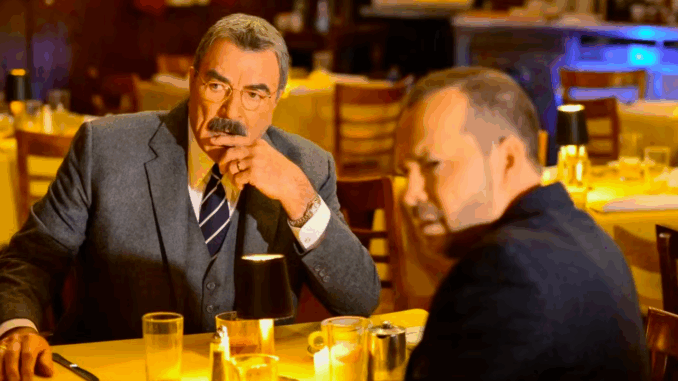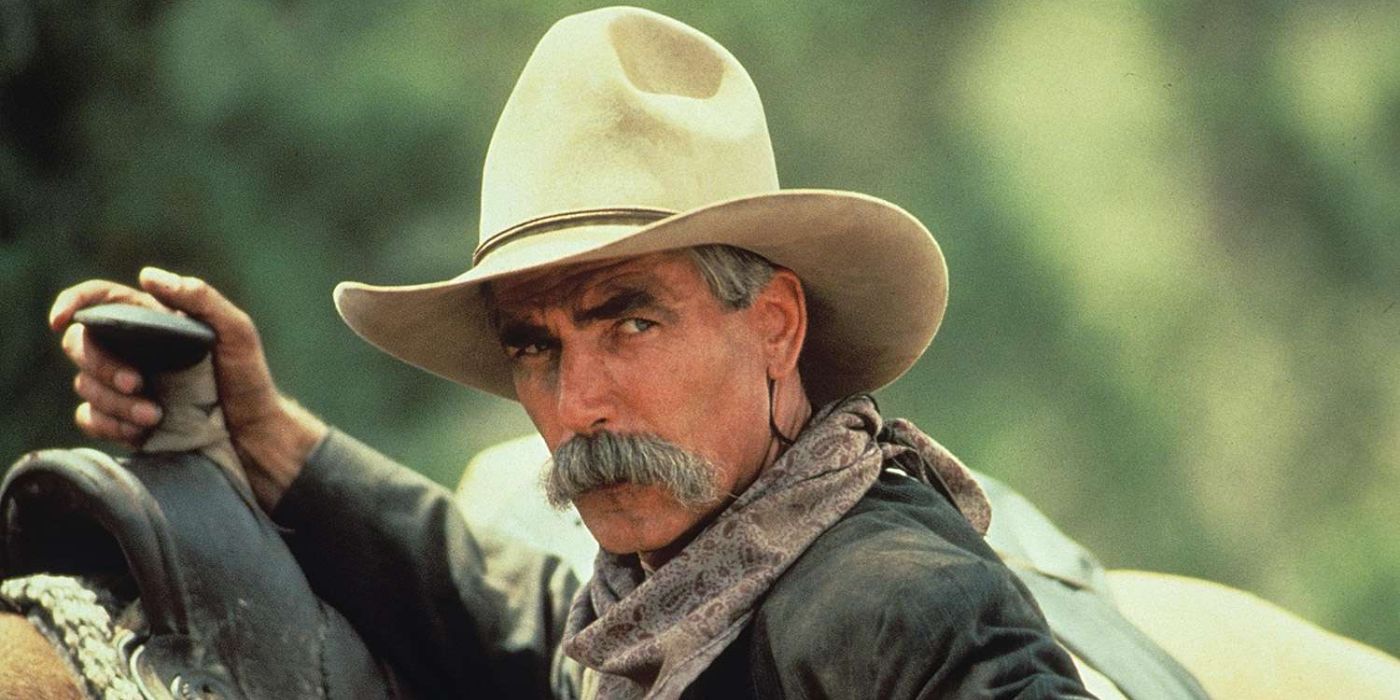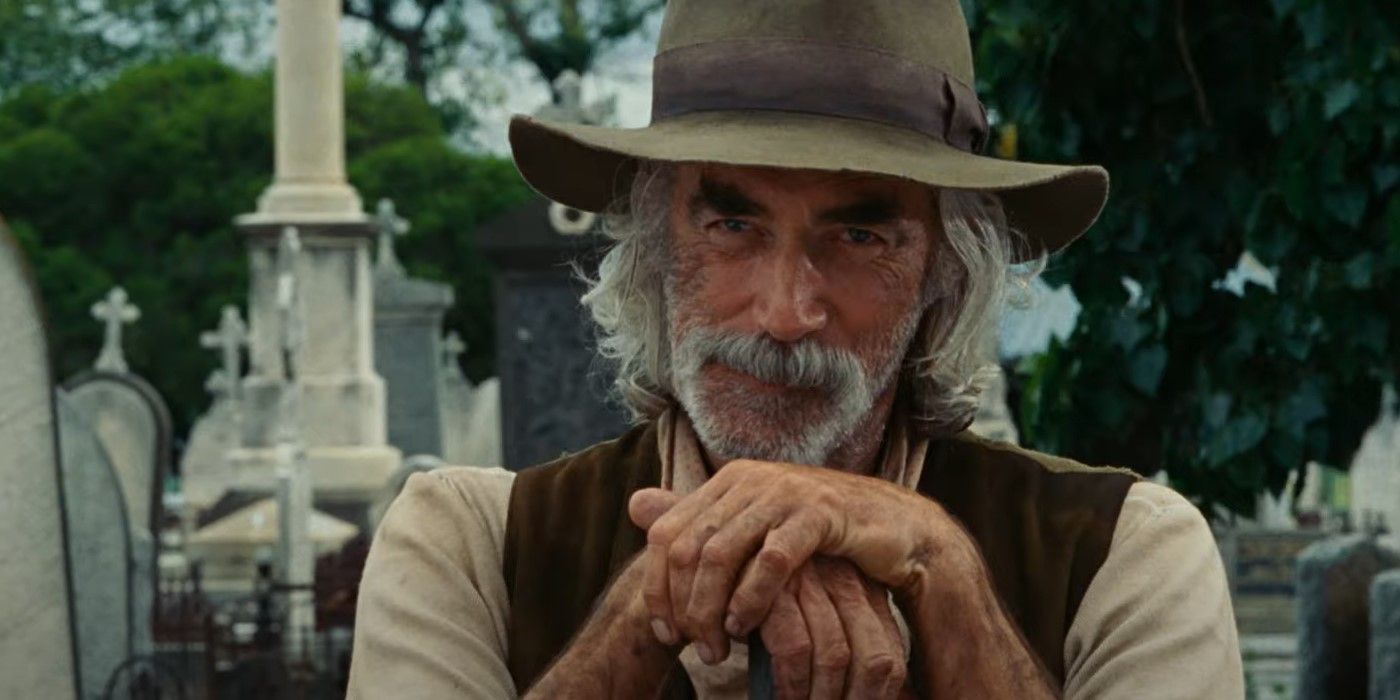
When Sam Elliott is brought up, only one genre comes to mind: the Western. Whether it’s his turn as Avery Markham in Justified or his time as the Caretaker in Ghost Rider, Elliott has repeatedly highlighted that he was born to star in the Wild West, in whatever form that may take. He often twists the genre, finding new ways to entertain audiences who are looking to return to a classic style of filmmaking for which the golden age has long since passed. Elliott has been involved in a couple of true classics over the years, including Tombstone, which he is perhaps fondly remembered for the most.
It’s hard to pinpoint exactly when Elliott’s career began to rise. While these days he’s a household name who elevates any cinematic picture he’s in, back in his early career, Elliott was constantly progressing with his character performances, and it’s difficult to say which specific outing ultimately led to his breakout moment. But, back in 1979, a much smaller production had caught the attention of genre fans, who were keen to follow the adaptation of a couple of classic texts. The Sacketts might be a bit of a cult favorite now, but at the time of its release, it sadly went unnoticed, and there’s a whole generation of viewers who are unaware of this project or do not recall its initial debut. This is, undoubtedly, a pivotal part of Elliott’s career and a great entry into the genre.
The Sacketts Takes Inspiration From Classic Literature
The Western Show Adapted Two Key Texts
The Sacketts was originally conceived as an idea by author Louis L’Amour in the early 1960s. The writer penned two novels set within that world, almost back-to-back (aside from 1960s Flint), with both 1960s The Daywalkers and 1961’s Sackett. However, the 19th-century American backdrop proved to be a wonderful setting to tell gripping, family-led stories, and so 17 novels were eventually published within the ongoing Sacketts series. Some of those novels include Sackett’s Land, Jubal Sackett, The Warrior’s Path, and War Party, with the saga coming to an end in the late 1990s. Louis L’Amour would make an incredible impact on the genre, and thus it was natural that this material was to be adapted.
But, it turns out that L’Amour’s work, over the years, was especially well-structured for big and small screen success aside from this Western series. In fact, novels like Crossfire Trail, The Iron Marshal, The Shadow Riders, The Broken Gun and Taggart are just a couple of examples of his work that ended up getting retold in a different medium. Perhaps most interesting of all, The Shadow Riders acted as a spiritual sequel of sorts to the adaptation of The Sacketts, as it starred both Sam Elliott and a couple of other returning cast members from The Sackett series, albeit in completely new roles. L’Amour’s bibliography had been hugely celebrated and honored during this time period, and yet, looking at the modern literary landscape and the adaptations being discussed, that name is nowhere to be seen.

The Sacketts itself is a phenomenal example of how one of his stories may translate to the small screen. Devised as a straight-to-TV movie, which was aired in two halves and therefore classified as a miniseries, The Sacketts followed a family who are trying to get married after the Civil War. With each brother having trodden very different paths and leaning into skills that the others do not possess, these are hard-working men who, by circumstance, find themselves directly in the eye of the storm. Indeed, the miniseries starts with a wedding and a murder revelation, which goes on to shape the rest of their lives.
The Sacketts covers such themes as immigration, the American dream, poverty, debt, familial breakdowns and law and order. It encompasses many of the tropes of the genre, but examines them through a new lens, as this family goes on a journey that will see them cross paths with law enforcement, survive plenty of classic shootouts, and come face to face with the infamous Bigelow gang. The Sacketts wasn’t a complete reinvention of the Western on the small screen by any means, and there’s a place for a debate to be had as to whether this narrative would have been even better suited in a feature-length setting, on the big screen. But the Western miniseries manages to touch on the major beats of the novel, while immersing viewers in this brutal and bleak landscape.
The Miniseries Was Defined By an Incredible Cast & Crew
Some All-Time Greats Brought Life to This Western Outing
The Sacketts itself is a phenomenal example of how one of his stories may translate to the small screen. Devised as a straight-to-TV movie, which was aired in two halves and therefore categorized as a miniseries, The Sacketts followed a family who are trying to get by after the Civil War. With each brother having trodden very different paths and leaned into skills that the others do not possess, these are hard-working men who, by circumstance, find themselves directly in the eye of the storm. Indeed, the miniseries starts with a wedding and a murder revelation, which goes on to shape the rest of their lives.
The Sacketts covers such themes as immigration, the American dream, poverty, debt, familial breakdowns and law and order. It encompasses many of the tropes of the genre, but examines them through a new lens, as this family goes on a journey that will see them cross paths with law enforcement, survive plenty of classic shootouts, and come face to face with the infamous Bigelow gang. The Sacketts wasn’t a complete reinvention of the Western on the small screen by any means, and there’s a place for a debate to be had as to whether this narrative would have been even better suited in a feature-length setting, on the big screen. But the Western miniseries managed to touch on the major beats of the novel, while immersing viewers in this brutal and bleak landscape.
The Miniseries Was Defined By an Incredible Cast & Crew
Some All-Time Greats Brought Life to This Western Outing
A great deal of respect has to be placed on the author for developing this story to start with. But The Sacketts’ portrayal of that narrative is also partially down to the incredible team that was put together to guide this ship. The Sacketts was given a slot on NBC, and thus would enjoy a huge audience base. With that in mind, a talented unit of veterans and newcomers ensured that the vision of the original text would be kept, introducing viewers to L’Amour’s work. Douglas Netter Productions, M.B. Scott Productions, Shalako Enterprises and Media Productions worked tirelessly on this project, with Executive Producers Douglas Netter and Jim Byrnes leading the charge. Netter had worked on major shows like Babylon 5 and The Wild West, while Byrnes has been a prolific writer on the likes of Knight Rider, How The West Was Won, and Gunsmoke.
Indeed, it was Byrnes who also wrote the adapted screenplay for The Sacketts, inspired by those two novels, with each half of the miniseries attempting to tackle a different piece of the source material. It was Robert Totten whose vision for the show was put forward as the be-all-and-end-all, with the writer and filmmaker stepping up as director here. Totten’s career is a complex one, with Death of a Gunfighter and The Wild Country highlighting some of his genre experience. The director also performed as an actor from time to time, notably appearing multiple times in Gunsmoke. He was joined by The Twilight Zone, Dallas and Gunsmoke alumnus Jerrold Immel, who composed on the project, and cinematographer Jack Whitman, whose filmography includes Hawaii Five-O, MacGyver and, of course, The Shadow Riders.
In front of the camera, besides Elliott, it was Tom Selleck and Jeff Osterhage who took the leads. Selleck was, of course, a star on the rise, and is now defined by shows like Friends, Magnum P.I. and Blue Bloods. His career speaks for itself, and Selleck provides both warmth and drama whenever he is on-screen, providing a physical presence and a gorgeously subtle series of performance choices that really focus in on that small-scale body language. Osterhage, on the other hand, never had quite the same opportunity to break out, but has consistently remained relevant with his career choices, with Dragnet, Baldur’s Gate, and Outlaws all added to his resume.
That ensemble was fleshed out with a combination of old-school performers and new-wave actors, including Glenn Ford of Superman fame, The Wild Bunch’s Ben Johnson, The Bad and the Beautiful’s Gilbert Roland, voice-acting standout John Vernon, and Strangers on a Train’s Ruth Roman, all bringing their talent to proceedings. Indeed, there are too many other standouts to mention, but the true soul of this piece comes down to those three brothers, who carry the conflicts on their backs and drive the miniseries towards its dramatic conclusion. While Selleck and Osterhage are more than ready to take that limelight, special mention has to go to Sam Elliott here, who, while still finding his feet, manages to give audiences a classic Western performance that should still be cherished.
Sam Elliott Shines In a Major Role
The Veteran’s Career Is Partially Defined By These Types Of Parts

Looking at Sam Elliott’s wider career, it’s perhaps easy to see how he has gotten to where he is today. He plays gruff, gritty and grounded characters just so well, but even behind those cold eyes, there’s a spark and a twinkle. He is able to play the villain with ease, but is much more believable as the underdog, who is somehow always on the verge of defeat and yet still gives the essence of strength. Throughout Elliott’s Western roles, he has demonstrated that it’s far more than just his vocal traits that ensure he’s perfect for the genre. And while it’s simple to paint him as the strong and silent type, watching from the wings and acting with great wisdom when needed, he should never be typecast in this manner.
Take the emotional range he demonstrates in A Star Is Born, for instance, of a man struggling to deal with the downfall of a family member, whom he both cares for and comes into conflict with in equal measure. Or look at his superhero work, where he somehow brings truth and realism to a world full of monsters, demons and all things outlandish. Those examples are in stark contrast to one another, but to really get a sense of how Elliott is able to balance all of these transitions, audiences should look no further than The Sacketts. Because not only is he in his element as part of a Western, with an undeniably stunning performance as Tell Sackett, one of the critical three brothers, but he also steps outside of his comfort zone and delivers some additional character nuance that would later come to shape his career.
Elliott delivers each line with strength and resolve in The Sacketts, but doesn’t miss a beat when it comes to the comical edge of some of those scenes. The Sacketts, at times, is somewhat held back by the time period that it’s filmed in, yet it’s Elliott who seems to understand the production he is in, and where it sits within the wider industry. It’s Elliott who can come across as threatening and oftentimes unstoppable, but it’s also Elliott who brings some levity to the equation, too. Even this much earlier into his career, before Elliott would be defined for his work in the genre’s own Tombstone, the actor was showing off some of those critical skills.
Tombstone is, by all accounts, probably Elliott’s best Western performance. There will be debates as to whether that statement really rings true for some audiences, but it’s a classic and one that saw Elliott really dial in to Virgil Earp as a critical supporting player and man of the law. It’s so often what’s happening in the mind that somehow plays on screen so effortlessly, that elevates Elliott’s portrayal of Earp, and that can be seen happening here in The Sacketts, too. Because the truth is, Elliott seems to carry a history with him wherever he goes, adding depth to each character. That’s absolutely the case in The Sacketts, as it is with Tombstone.
The Sacketts Has Unfortunately Been Forgotten
The Miniseries Failed to Find Its Audience & Has Been Overlooked By Critic
The Sacketts has somehow, despite Elliott’s performance, the strength of the material and the talent behind the camera, largely been forgotten by audiences. Indeed, even at the time of its release, the miniseries failed to gain much in the way of critical momentum. There were no standout award appearances, no major write-ups in significant publications to make note of, and no lasting legacy. When talking about great Western TV shows, The Sacketts is almost never mentioned, and that may be, in part, because of its status as a miniseries. Perhaps if it really did get that feature-length treatment, it would have been able to stand the test of time.
Audiences should thus go back to this miniseries, not just because of its status within the wider industry, but to also give Elliott’s early performance a chance. For those who want to see a star develop into the modern-day Western icon that he has now become, this really is a critical piece of the puzzle. What’s more, viewers will be able to see that, actually, The Sacketts is one of the greatest Western TV shows of all time that never got the fanfare that it deserved. Unlike some Westerns of the era, the show is able to transport its viewers to yesteryear and to an entirely new location, completely engaging them in this different way of life.
The Sacketts deserves all the praise that it unfortunately never got, but the legacy of the series can begin anew again. With potential for the author’s work to be adapted once more down the line, perhaps The Sacketts will eventually be revisited for inspiration and to get an idea of how this material has evolved over time. For those who have fallen in love with this genre, this is a well-paced and articulate example of how there are still quality pieces to be found that haven’t taken the limelight.
